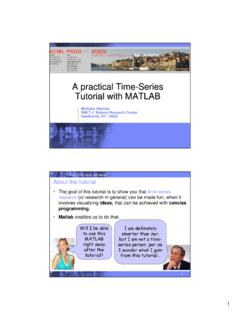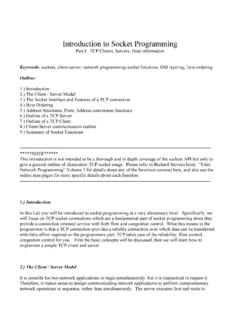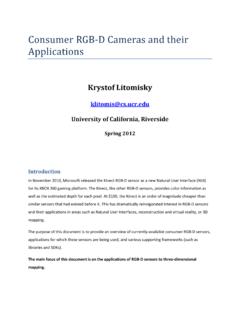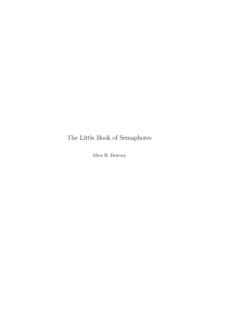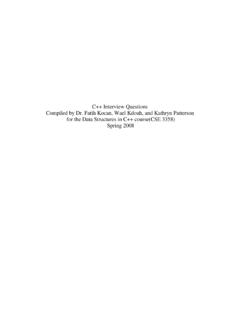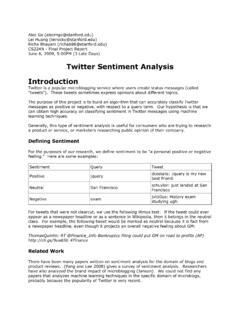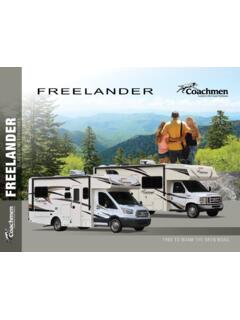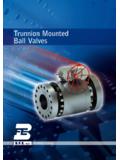Transcription of Selective Bayesian Classifier: Feature Selection for the ...
1 Scaling up the Naive Bayesian classifier : Using Decision Trees for Feature Selection Chotirat Ann Ratanamahatana Dimitrios Gunopulos Computer Science Department University of California Riverside, CA 92521 1-909-787-5190 {ratana, ABSTRACT It is known that Na ve Bayesian classifier (NB) works very well on some domains, and poorly on some. The performance of NB suffers in domains that involve correlated features. decision trees, on the other hand, typically perform better than the Na ve Bayesian algorithm on such domains.}
2 This paper describes a Selective Bayesian classifier (SBC) that simply uses only those features that would use in its decision tree when learning a small example of a training set, a combination of the two different natures of classifiers. Experiments conducted on ten datasets indicate that SBC performs reliably better than NB on all domains, and SBC outperforms on many datasets of which outperform NB. Augmented Bayesian classifier (ABC) are also tested on the same data, and SBC appears to perform as well as ABC.
3 SBC also can eliminate, on most cases, more than half of the original attributes, which can greatly reduce the size of the training and test data, as well as the running time. Further, the SBC algorithm typically learns faster than both and NB, needing fewer training examples to reach high accuracy of classification. Keywords , Decision Trees, Feature Selection , Na ve Bayesian classifier , Selective Bayesian classifier . 1. INTRODUCTION Two of the most widely used and successful methods of classification are decision trees [25] and Na ve Bayesian learning (NB) [10].
4 While constructs decision trees by using features to try and split the training set into positive and negative examples until it achieves high accuracy on the training set, NB represents each class with a probabilistic summary, and finds the most likely class for each example it is asked to classify. Several researchers have emphasized on the issue of redundant attributes, as well as advantages of Feature Selection for the Na ve Bayesian classifier , not only for induction learning.
5 Pazzani [22, 23] explores the methods of joining two (or more) related attributes into a new compound attribute where the attribute dependencies are present. Another method, Boosting on Na ve Bayesian classifier [10] has been experimented by applying series of classifiers to the problem and paying more attention to the examples misclassified by its predecessor. However, it was shown that it fails on average in a set of natural domain [19]. Langley and Sage [18] use a wrapper approach for the subset Selection to only select relevant features for NB.
6 Cardie [5] uses the attributes from decision trees in combination with nearest neighbor methods. And in a domain for discovering patterns in EEG-signals, Kubat, Flotzinger, and Pfurtscheller [7] tried the use of Decision tree in Feature Selection for Na ve Bayesian classifier . And recently, Augmented Bayesian Classifiers [14] was introduced as another approach where Na ve Bayes is augmented by the addition of correlation arcs between attributes.
7 It has been shown that Na ve Bayesian classifier is extremely effective in practice and difficult to improve upon [8]. In this paper, we show that it is possible to reliably improve this classifier by using a Feature Selection method. Na ve Bayes can suffer from oversensitivity to redundant and/or irrelevant attributes. If two or more attributes are highly correlated, they receive too much weight in the final decision as to which class an example belongs to.
8 This leads to a decline in accuracy of prediction in domains with correlated features. does not suffer from this problem because if two attributes are correlated, it will not be possible to use both of them to split the training set, since this would lead to exactly the same split, which makes no difference to the existing tree. This is one of the main reasons performs better than NB on domains with correlated attributes. We conjecture that the performance of NB improves if it uses only those features that used in constructing its decision tree.
9 This method of Feature Selection would also perform well and learn quickly, that is, it would need fewer training examples to reach high classification accuracy. We present experimental evidence that this method of Feature Selection leads to improved performance of the Na ve Bayesian classifier , especially in the domains where Na ve Bayes performs not as well as We analyze the behavior on ten domains from the UCI repository, 5 of which achieves asymptotically higher accuracy than NB (which seems to imply the presence of correlated features.)
10 , and 5 on which NB outperforms We then compared our algorithm with the Augmented Bayesian classifier (ABC), and the experimental results justify our expectation. We also tested SBC on another sufficiently large synthetic dataset and our algorithm appeared to scale nicely. Our Selective Bayesian classifier always outperforms NB and performs as well as, or better than both and ABC on almost all the domains. 2. NA VE Bayesian classifier Description The Na ve Bayesian classifier is a straightforward and frequently used method for supervised learning.
